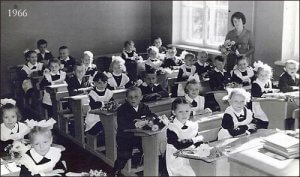О картине Ивана Ивановича Шишкина “Утро в сосновом лесу”



I have always loved going to the countryside. My grandma lived about 40 km away from Moscow and our extended family had several small plots of land that were the source of a lot of work and a lot of great food. Read More
When I was thirty, it was time for me to send my almost 7-year old daughter to school. There were a lot of preparations before her first day. I took great care in choosing her school uniform – a dress made of thin brown wool, with wide pleats on the skirt and a festive white apron from thin cambric material. The collar and the cuffs of the dress were trimmed with real white lace. The ribbons for her hair were made of crisp white gauze. I bought her pretty white tights and beautiful white shoes. I wanted to be sure she would look her best during the celebration of her first day of school.
There was a lot more to put together. Briefcases were no longer popular at that time, and everyone was looking for a satchel with pretty designs of animal faces or cartoon characters or cars. The satchels were comfortable with wide adjustable straps and preferably with some padding for the back, so it was easier for our kids to carry their first books to school. I made sure I got one for her. Read More

When I remember my first day at school, there was no celebration. Just before that long anticipated day I got a beautiful brown leather briefcase with a silver buckle at the end of year celebration at my kindergarten. It had a case for pens, a Bukvar (the textbook to learn reading), cut up letters and numbers, and colorful pencils, a pen, an eraser, some paints, a paintbrush and a collection of multi-colored craft paper. I was ready to take it all with me to my first day of school. However I did not get to do it, and I did not get to put on my new brown dress with a white apron (the school uniform) and there were no big white ribbons in the hair for me. Read More
Every culture possesses a different understanding of what humor is, what humor means to people and how they respond to it.
“Humor usually concerns aspects of culture and depends on the historical and current development of the country’s culture.”
In order to understand the humor in the joke, especially if a joke is too closely linked to a specific characteristic of a country, one has to get familiar with that culture.
A most common form of Russian humor that you will hear is a short fictional story or dialogue with a punch line. In Russian it is called an anecdote [анекдот]. However, anecdotes are not just jokes because their purpose is not only to make somebody laugh, but also to reveal a more general truth. The most popular joke topics include politics, sex and mothers-in-law. Read More
We love hearing personal stories about how the other culture, language, country changes us or makes us realize something about ourselves we have never thought about.
Here is a very personal post about a new “hybrid” value system that one of our customers had to construct for herself after her move to the US from Russia:
I moved to the United States of America in my early 20-s and have gone through a complicated and sometimes painful process of adjusting to the new culture, of forging a new identity. I was faced with the identity dilemma, with the question of “who am I?”
“(Culture) is a pattern of perceptions, values, attitudes, and behaviors that are accepted and expected by an identity group.” M. Singer Read More
I had some great feedback on part one of this project and am looking forward to posting many more insightful answers I have received.
This week I want to introduce you to another wonderful teacher in my life – James Toland. He is a great vocal coach, chorus master, and loves languages a
I have been asked this question many times and usually, the answer I give is: because I like it! But the other day talking to one of my friends about the bilingual and multilingual speakers and why it happens, I realized that most everyone has a very interesting story behind. I decided to ask people some questions but will start with my own answers:
1) Why do you speak more than 
2) How many languages do you speak and to what degree?
3) When, where and why did you learn your first non-native language?
4) Why other languages and in what order?
5) What language would you like/do you think you will learn next?

The game started in English by my husband and they were going strong for a good 20-25 minute period, at which point my husband was done with the game…my daughter was not! So I was volunteered to continue on and instead of doing it in English, the rules changes to doing it in Russian. We started with colors, then moved to objects and then ended with everything and anything. It was so much fun! I figured out several words she was missing and mispronouncing in Russian, she learned several new words and even my husband did (talk about sneaking in teaching him Russian!). Read More